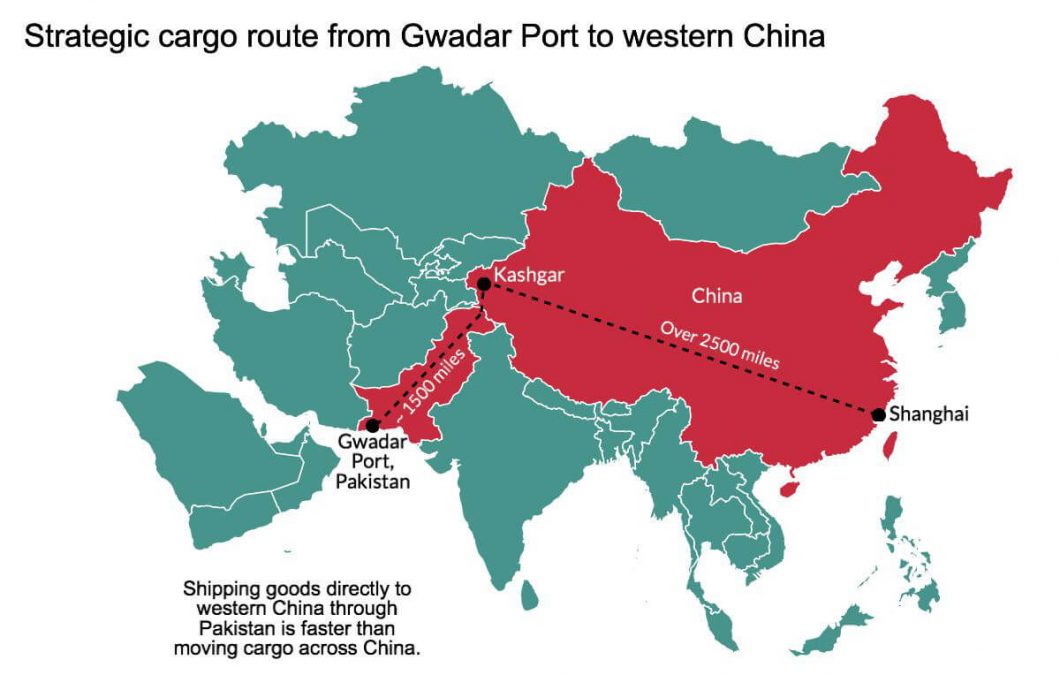In 1958, Pakistan spent US $3 million to buy the Gwadar port, in its own Balochistan province, from the Sultanate of Oman.
Pakistan has been a poor caretaker of its national assets, Gwadar port is owned by the Pakistan government’s Gwadar Port Authority (GPA) and operated by state-run Chinese firm China Overseas Port Holding Company (COPHC), which has a 45 year lease.
Gwadar port:
- 45 miles away from the Iran border and the Gulf of Oman, at the mouth of the Persian Gulf and close to the Strait of Hormuz, the only sea passage from the Persian Gulf to the open ocean, through which +/-40% of the world’s oil passes
- Allows China to unload petroleum products from Gulf countries and then transport them through a 2,000 mile long land route ending at Kashgar, the biggest commercial center in the Xinjiang province of north-western China.
The current transit route is through the Straits of Malacca, the main shipping channel between the Indian Ocean and the Pacific Ocean, which hosts more than 30% of the world’s seaborne trade. Approximately 80% of China’s energy supply ships through those Straits from the Middle East. The Gwadar port reduces the distance from West Asia to China via the blockade vulnerable and pirate plagued Malacca Straits by as much as 10 to 12 days, it cuts the current 7,000 mile journey to 1500 miles.
The port is at the confluence with
- China Pakistan Economic Corridor (CPEC) an enormous infrastructure project that is an arterial road lifeline running almost 2000 miles linking Xinjiang, where there is a high population of tortured ethnic Uyghur, through the Khunjerab Pass, Gilgit, Pakistan occupied Kashmir, Islamabad and then to Gwadar.
- Chinese “String of Pearls” which is a waterways course that includes:
- Kayakphu Port in Myanmar
- Ports in Bangladesh
- Hambantota in Sri Lanka, which had to grant a 99-year lease and 70 percent stake to China.
Effectively, China will be holding hostage landlocked Central Asian Countries for access to the sea lanes.
For Pakistan, their $3 million dollar investment has had a remarkable yield, for China.
Interest rates on Chinese loans are steep, 91 percent of revenues from Gwadar Port go to China.
This is Chinese predatory lending, it’s designed to seize the underlying assets…
- Maldives owes China 1.5 billion or 30 percent of its GDP
- Djibouti owes 80% of its GDP to China.
China’s military
All this gives the Chinese a permanent military base in the Arabian Sea and extends its Navy’s logistics support capabilities at their facilities in the Duqm Port, Oman.
With the financially troubled base at Djibouti, where they maintain a marine contingent, their capabilities cover the Gulf of Aden and the east African coastline.
The Chinese Communist Party ambition is a 100,000 strong Marine Corps increasing its naval belligerence and expanding its huge expeditionary forces which would deploy primarily from Djibouti and Gwadar.
China is building large amphibious landing docks with ships having a capability to carry up to 30 helicopters. They have two aircraft carriers today and will have five to six by 2030, they have +/- 70 submarines.
Pakistan’s failure are China’s victories, debts still have to be repaid or it surrenders its port. Soon…
The Gwadar port was opened for commercial traffic in 2019. However…
- It has inadequate coastal traffic, its utilization is at marginal levels.
- The China initiated free trade zone planned at Gwadar has not progressed as planned, resulting in further impeding the growth of import and export volumes.
- A surge in high cost imports needed to further develop Gwadar port caused a drop in available construction materials.
- There is a preference by Afghanistan to use the Chabahar Port in Iran.
Pakistan has run out of money and run out of leverage, befallen by
- Massive corruption
- Almost impossible to increase tax revenues as only 1 percent of population file income tax returns. The tax-to-GDP ratio of 12 percent, one of the lowest globally.
- In an attempt to escape a “balance of payments crisis”, Pakistan’s central bank devalued the currency four times since December 2017, which has led to the weakening of its rupee by more than 20 percent.
The Gwadar port is priceless for China and on sale by Pakistan
